Nizhny Novgorod
| Nizhny Novgorod (English) Нижний Новгород (Russian) Gorky (1932 - 1990) | |
|---|---|
| - City[1] - | |
.png) Clockwise: The Kremlin, Chkalov Stairs, Minin and Pozharsky Square, the State Bank, the Fair, Saint Alexander Nevsky cathedral. | |
.svg.png) Location of Nizhny Novgorod Oblast in Russia | |
.svg.png) Nizhny Novgorod | |
|
| |
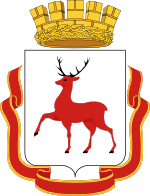 |
|
|
| |
| City Day | 12 June[2] |
| Administrative status (as of November 2011) | |
| Country | Russia |
| Federal subject | Nizhny Novgorod Oblast[1] |
| Administratively subordinated to | city of oblast significance of Nizhny Novgorod[1] |
| Administrative center of | Nizhny Novgorod Oblast,[1] city of oblast significance of Nizhny Novgorod[1] |
| Municipal status | |
| Urban okrug | Nizhny Novgorod Urban Okrug[3] |
| Administrative center of | Nizhny Novgorod Urban Okrug[3] |
| Head[4] | Ivan Karnilin[5] |
| Representative body | City Duma[6] |
| Statistics | |
| Area | 460 km2 (180 sq mi)[7] |
| Population (2010 Census) | 1,250,619 inhabitants[8] |
| - Rank in 2010 | 5th |
| Density | 2,719/km2 (7,040/sq mi)[9] |
| Time zone | MSK (UTC+03:00)[10] |
| Founded | 1221[11] |
| City status since | 1221[11] |
| Previous names |
Nihny Novgorod (until 1932),[12] Gorky (until 1990)[12] |
| Postal code(s)[13] | 603000-603999 |
| Dialing code(s) | +7 831[14] |
|
| |
| Nizhny Novgorod on Wikimedia Commons | |

Nizhny Novgorod (Russian: Ни́жний Но́вгород; IPA: [ˈnʲiʐnʲɪj ˈnovɡərət]), colloquially shortened to Nizhny, is a city. The administrative center of Nizhny Novgorod Oblast and Volga Federal District. From 1932 to 1990, it was known as Gorky (Горький, IPA: [ˈɡorʲkʲɪj]),[15] after the writer Maxim Gorky, who was born there. The city is an important economic, transportation and cultural center in Russia and the vast Volga-Vyatka economic region, and is the main center of river tourism in Russia. In the historical part of the city there are a large number of universities, theaters, museums and churches. Nizhny Novgorod is located about 400 km east of Moscow, where the Oka empties into the Volga. Population: 1,250,619 (2010 Census);[8] 1,311,252 (2002 Census);[16] 1,438,133 (1989 Census).[17]
The city was founded in 1221 by Prince Yuri II of Vladimir. In 1612 Kuzma Minin and Prince Dmitry Pozharsky organized a big army for the liberation of Moscow from the Poles. In 1817 Nizhny Novgorod became a great trade center of the Russian Empire. In 1896 at a fair, an All-Russia Exhibition was organized.
During the Soviet period, the city turned into an important industrial center. In particular, the Gorky Automobile Plant was constructed in this period. During the World War II Gorky became the biggest provider of military equipment to the front. Due to this, the Luftwaffe constantly bombed the city from the air. The majority of the German bombs fell in the area of the Gorky Automobile Plant. Although almost all the production sites of plant were completely destroyed, the citizens of Gorky reconstructed the factory after 100 days.
After the war, Gorky became a "closed city" and remained one until after the dissolution of the Soviet Union in 1990. At that time the city was renamed back to Nizhny Novgorod.
In 1985 the metro was opened. In 2016 Vladimir Putin opened the new 70th Anniversary of Victory Plant which is part of the Almaz-Antey Air and Space Defence Corporation.
The Kremlin – the main center of the city – contains the main government agencies of the city and the Volga Federal District.
History
Name
Originally the name was just Novgorod ("Newtown"), but to distinguish it from the other, older and well-known Novgorod to the north, the city was commonly called "Novgorod of the Lower lands". This land was named "lower" because it is situated downstream, especially from the point of view of other Russian cities such as Moscow, Vladimir and Murom. Later it was transformed into the contemporary name of the city that literally means "Lower Newtown".
Seat of medieval princes
The city traces its origin from a small Russian wooden hillfort that was founded by Grand Duke Yury II in 1221 at the confluence of two of the most important rivers in his principality, the Volga and Oka rivers. Its independent existence was threatened by the continuous Mordvin attacks against it; the major attempt made by forces under Purgaz in April 1229 was repulsed, but after the death of Yury II on March 4, 1238 at the Battle of the Sit River, the Mongols occupied the fortress. Later a major stronghold for border protection, Nizhny Novgorod fortress took advantage of a natural moat formed by the two rivers.
Along with Moscow and Tver, Nizhny Novgorod was among several newly founded towns that escaped Mongol devastation on account of their insignificance, but grew into (great) centers in vassalic Russian political life during the period of the Tatar Yoke. With the agreement of the Mongol Khan, Nizhny Novgorod was incorporated into the Vladimir-Suzdal Principality in 1264. After 86 years its importance further increased when the seat of the powerful Suzdal Principality was moved here from Gorodets in 1350. Grand Duke Dmitry Konstantinovich (1323–1383) sought to make his capital a rival worthy of Moscow; he built a stone citadel and several churches and was a patron of historians. The earliest extant manuscript of the Russian Primary Chronicle, the Laurentian Codex, was written for him by the local monk Laurentius in 1377.
Strongest fortress of the Grand Duchy of Moscow

After the city's incorporation into the Grand Duchy of Moscow in 1392, the local princes took the name Shuisky and settled in Moscow, where they were prominent at the court and briefly ascended the throne in the person of Vasily IV. After being burnt by the powerful Crimean Tatar chief Edigu in 1408, Nizhny Novgorod was restored and regarded by the Muscovites primarily as a great stronghold in their wars against the Tatars of Kazan. The enormous red-brick kremlin, one of the strongest and earliest preserved citadels in Russia, was built in 1508–1511 under the supervision of Peter the Italian. The fortress was strong enough to withstand Tatar sieges in 1520 and 1536.
In 1612, the so-called national militia, gathered by a local merchant, Kuzma Minin, and commanded by Knyaz Dmitry Pozharsky expelled the Polish troops from Moscow, thus putting an end to the "Time of Troubles" and establishing the rule of the Romanov dynasty. The main square before the Kremlin is named after Minin and Pozharsky, although it is locally known simply as "Minin Square." Minin's remains are buried in the citadel. (In commemoration of these events, on October 21, 2005, an exact copy of the Red Square statue of Minin and Pozharsky was placed in front of St John the Baptist Church, which is believed to be the place from where the call to the people had been proclaimed.)
In the course of the following century, the city prospered commercially and was chosen by the Stroganovs (the wealthiest merchant family of Russia) as a base for their operations. A particular style of architecture and icon painting, known as the Stroganov style, developed there at the turn of the 19th and 20th centuries.
The historical coat of arms of Nizhny Novgorod in 1981 was a red deer with black horns and hooves on a white field. The modern coat of arms circa 1992 is the same, but the shield can be adorned with golden oak leaves tied with a ribbon with colours of the Russian national flag.
Great trade center

In 1817, the Makaryev Fair, one of the liveliest in the world, was transferred to Nizhny Novgorod, and started to attract millions of visitors annually. By the mid-19th century, the city was firmly established as the trade capital of the Russian Empire. The world's first radio receiver by engineer Alexander Popov and the world's first hyperboloid tower and lattice shell-coverings by engineer Vladimir Shukhov were demonstrated at the All-Russia industrial and art exhibition in Nizhny Novgorod in 1896. According to official Imperial Russian statistics the population of Nizhny Novgorod as of 14 January 1913 was 97,000.
The largest industrial enterprise was the Sormovo Iron Works which was connected by the company's own railway to Moscow station in the upper part of Nizhny Novgorod. The private Moscow to Kazan Railway Company's station was in the lower part of the city. Other industries gradually developed, and by the start of the 20th century the city was also a first-rank industrial hub. Henry Ford helped build a large truck and tractor plant (GAZ) in the late 1920s, sending engineers and mechanics, including future labour leader Walter Reuther.
Soviet era
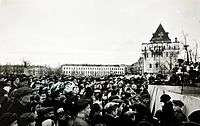
There were no permanent bridges over the Volga or Oka before the October Revolution in 1917. Temporary bridges were built during the trade fair. The first bridge over the Volga was started by the Moscow-Kazan Railway Company in 1914, but only finished in the Soviet Era when the railway to Kotelnich was opened for service in 1927.
Maxim Gorky was born in Nizhny Novgorod in 1868 as Alexey Maximovich Peshkov. In his novels he described the dismal life of the city proletariat.
Already during his lifetime, the city was renamed Gorky following his return to the Soviet Union in 1932 on the invitation of Joseph Stalin. The city bore Gorky's name until 1990. His childhood home is preserved as a museum, known as the Kashirin House, after Alexey's grandfather who owned the place.
During much of the Soviet era, the city was closed to foreigners to safeguard the security of Soviet military research and production facilities, even though it was a popular stopping point for Soviet tourists traveling up and down the Volga in tourist boats. Unusually for a Soviet city of that size, even street maps were not available for sale until the mid-1970s.
Mátyás Rákosi, communist leader of Hungary, died there in 1971. The physicist and Nobel laureate Andrei Sakharov was exiled there during 1980-1986 to limit his contacts with foreigners.
An end to the "closed" status of the city accompanied the reinstatement of the city's original name in 1990.[15]
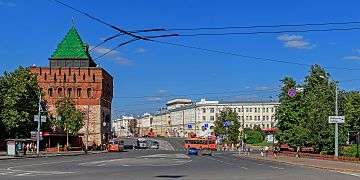 Demetrius tower of the Kremllin
Demetrius tower of the Kremllin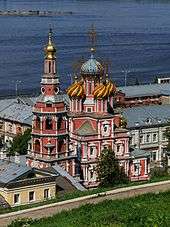 Church of the Nativity of Our Lady
Church of the Nativity of Our Lady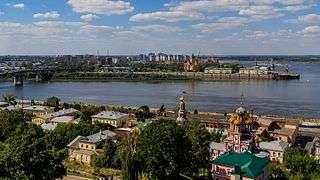 Spit of Oka and Volga Rivers
Spit of Oka and Volga Rivers
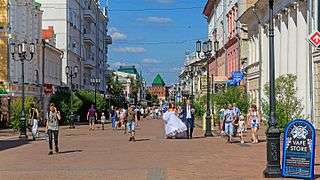 Bolshaya Pokrovskaya Street
Bolshaya Pokrovskaya Street
Administrative and municipal status
Nizhny Novgorod is the administrative center of the oblast.[1] Within the framework of administrative divisions, it is, together with one resort settlement and twelve rural localities, incorporated as the city of oblast significance of Nizhny Novgorod—an administrative unit with the status equal to that of the districts.[1] As a municipal division, the city of oblast significance of Nizhny Novgorod is incorporated as Nizhny Novgorod Urban Okrug.[3]
City layout and divisions
Nizhny Novgorod is divided by the Oka River into two distinct parts. The Upper City (Russian: Нагорная часть, Nagornaya chast, Mountainous part) is located on the hilly eastern (right) bank of the Oka. It includes three of the eight city districts into which the city is administratively divided:
- Nizhegorodsky (the historical and administrative center of the city);
- Prioksky;
- Sovetsky.
The Lower City (Russian: Заречная часть, Zarechnaya chast, Over river part) occupies the low (western) side of the Oka, and includes five city districts:
- Avtozavodsky (built around the GAZ automotive plants);
- Kanavinsky (the site of the Nizhny Novgorod Fair and the location of the main train station);
- Leninsky.
- Moskovsky (home of the Sokol Aircraft Plant and its airfield);
- Sormovsky (where Krasnoye Sormovo and the Volga Shipyard are located);
All of today's lower city was annexed by Nizhny Novgorod in 1929–1931.
Demographics
- Population: 1,250,619 (2010 Census);[8] 1,311,252 (2002 Census);[16] 1,438,133 (1989 Census).[17]
- Births (2009): 12,934
- Deaths (2009): 20,987
Nizhny Novgorod is the fifth largest city in Russia, ranking after Moscow, St. Petersburg, Novosibirsk, and Yekaterinburg.
Geographу and climate
Time

Nizhny Novgorod is located in the Moscow Time time zone. The areas operate in what is referred to in international standards as Moscow Standard Time (MSK, мск), which is 3 hours ahead of UTC, or UTC+3. Daylight saving time is no longer observed.
Climate
The climate in the region is continental, specifically humid continental (Dfb), and it is similar to the climate in Moscow, although colder in winter, which lasts from late November until late March with a permanent snow cover. Average temperatures range from +19 °C (66 °F) in July to −9 °C (16 °F) in January.
A maximum temperature of +38.2 °C (100.8 °F) was recorded during the 2010 Northern Hemisphere summer heat waves.
| Climate data for Nizhny Novgorod | |||||||||||||
|---|---|---|---|---|---|---|---|---|---|---|---|---|---|
| Month | Jan | Feb | Mar | Apr | May | Jun | Jul | Aug | Sep | Oct | Nov | Dec | Year |
| Record high °C (°F) | 5.7 (42.3) |
7.0 (44.6) |
17.3 (63.1) |
26.3 (79.3) |
32.5 (90.5) |
36.3 (97.3) |
38.2 (100.8) |
38.0 (100.4) |
31.0 (87.8) |
24.2 (75.6) |
13.8 (56.8) |
8.5 (47.3) |
38.2 (100.8) |
| Average high °C (°F) | −5.9 (21.4) |
−5.3 (22.5) |
1.1 (34) |
10.9 (51.6) |
18.7 (65.7) |
22.6 (72.7) |
24.7 (76.5) |
22.1 (71.8) |
15.6 (60.1) |
8.0 (46.4) |
−0.5 (31.1) |
−4.7 (23.5) |
8.9 (48) |
| Daily mean °C (°F) | −8.9 (16) |
−8.7 (16.3) |
−2.6 (27.3) |
6.1 (43) |
12.9 (55.2) |
17.2 (63) |
19.4 (66.9) |
16.9 (62.4) |
11.1 (52) |
4.7 (40.5) |
−2.8 (27) |
−7.4 (18.7) |
4.8 (40.6) |
| Average low °C (°F) | −11.6 (11.1) |
−11.7 (10.9) |
−5.8 (21.6) |
2.1 (35.8) |
7.9 (46.2) |
12.6 (54.7) |
14.8 (58.6) |
12.6 (54.7) |
7.6 (45.7) |
2.1 (35.8) |
−4.8 (23.4) |
−9.9 (14.2) |
1.3 (34.3) |
| Record low °C (°F) | −41.2 (−42.2) |
−37.2 (−35) |
−28.3 (−18.9) |
−19.7 (−3.5) |
−6.9 (19.6) |
−1.8 (28.8) |
4.6 (40.3) |
0.9 (33.6) |
−5.5 (22.1) |
−16.0 (3.2) |
−29.4 (−20.9) |
−41.4 (−42.5) |
−41.4 (−42.5) |
| Average precipitation mm (inches) | 47 (1.85) |
38 (1.5) |
37 (1.46) |
36 (1.42) |
46 (1.81) |
76 (2.99) |
73 (2.87) |
69 (2.72) |
61 (2.4) |
64 (2.52) |
55 (2.17) |
55 (2.17) |
657 (25.87) |
| Average rainy days | 5 | 4 | 5 | 13 | 17 | 19 | 18 | 18 | 18 | 18 | 10 | 6 | 151 |
| Average snowy days | 28 | 24 | 18 | 7 | 1 | 0.1 | 0 | 0 | 1 | 8 | 20 | 26 | 133 |
| Average relative humidity (%) | 86 | 81 | 74 | 64 | 60 | 69 | 70 | 74 | 79 | 82 | 87 | 86 | 76 |
| Mean monthly sunshine hours | 43 | 79 | 145 | 196 | 275 | 287 | 280 | 238 | 152 | 81 | 38 | 25 | 1,839 |
| Source #1: Pogoda.ru.net[18] | |||||||||||||
| Source #2: NOAA (sun 1961–1990)[19] | |||||||||||||
Economy

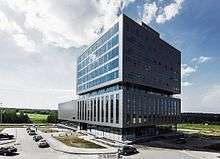
Information technology
Nizhny Novgorod is one of the centers of the IT Industry in Russia. It ranks among the leading Russian cities in terms of the quantity of software R&D providers. Intel has a big software R&D center with more than 500 engineers in the city, as well as a major datacenter. In Nizhny Novgorod there is also a number of offshore outsourcing software developers, including Bell Integrator, Itseez, Tecom, Luximax Systems Ltd., MERA Networks, RealEast Networks, Auriga, SoftDrom, and Teleca, and many other smaller companies specializing in the delivery of services to telecommunication vendors.
There are twenty-five scientific R&D institutions focusing on telecommunications, radio technology, theoretical and applied physics, and thirty-three higher educational institutions, among them are Nizhny Novgorod State Medical Academy, Nizhny Novgorod State University, Nizhny Novgorod Technical University, as well as Nizhny Novgorod Institute of Information Technologies, that focuses on information technologies, software development, system administration, telecommunications, cellular networks, Internet technologies, and IT management.
Nizhny Novgorod has also been chosen as one of four sites for building an IT-oriented technology park—a special zone that has an established infrastructure and enjoys a favorable tax and customs policy.
Engineering industry
The engineering industry is the leading industry of Nizhny Novgorod economy. It is mainly oriented towards transportation, i.e., the auto industry, shipbuilding, diesel engines, aircraft manufacture, and machine tools, with the auto industry being the leading sector (50%). Largest plants include:
- JSC "Gorky Automobile Plant" - personal cars, trucks, armored personnel carriers, and other autos;
- JSC "Krasnoye Sormovo" - river and sea ships, submarines;
- JSC "Sokol" - airplanes, jets;
- JSC "Hydromash"- hydraulic actuators, landing gears
- JSC "Nitel" - TV sets;
- JSC "RUMO" - diesel generators;
- JSC "Krasny yakor" - anchor chains;
Transportation
Railway

The Gorkovskaya Railroad, a Russian Railways department which operates some 5,700 kilometers (3,500 mi) of rail lines throughout the Middle Volga region and 1,200 kilometers (750 mi) in Nizhny Novgorod Oblast, is headquartered in Nizhny Novgorod. Since 1862, there has been a railway connection between Nizhny Novgorod and Moscow.[20] Overnight trains provide access to Nizhny Novgorod from Moscow, Saint Petersburg, Kazan, Yaroslavl and others. Since December 2002, a fast train transports passengers between Nizhny Novgorod and Moscow in less than five hours. One can continue from Nizhny Novgorod eastward along the Trans-Siberian Railway, with direct trains to major cities in the Urals and Siberia, as well as to Beijing, Pyongyang, and Ulan-Bator.
The first high-speed rail Sapsan train to Moscow (Kursky Rail Terminal) and Saint Petersburg (Moskovsky Rail Terminal) was launched on July 30, 2010.[21]
Suburban commuter trains (elektrichka) connect Nizhny Novgorod with Vladimir, Dzerzhinsk, Murom, Kirov, Arzamas, Zavolzhye, Balakhna, and others.
Waterways
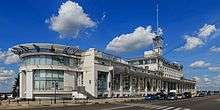
Nizhny Novgorod is an important center of Volga cargo and passenger shipping. During summer, cruise vessels operate between Nizhny Novgorod, Moscow, Saint Petersburg, and Astrakhan. In 2006 a small number of Meteor-class hydrofoils resumed operations on the Volga river.
Highway
The city is served by the Russian highway M-7 (Moscow – Nizhny Novgorod – Kazan – Ufa), and is a hub of the regional highway network.
Intercity buses
The system of Nizhny Novgorod's bus terminals underwent significant changes in 2015, as the old main intercity bus terminal in Lyadov Sq (just south of downtown) closed, and a new bus terminal opened in Scherbinki, a few miles to the south.[22][23] Presently, the city's main bus terminals are the following:
- Kanavino Bus Station, near the Moscow Railway Station. Mostly serves directions west and northwest (e.g. toward Moscow)
- Scherbinki Bus Station, a few miles south of downtown. Mostly serves directions east and south.
Out of the three bus terminals, only the Kanavino station is near a subway line; the other two are connected with the rest of the city by city buses.
Local public transportation

Public transportation within the city is provided by a tramways, marshrutkas (routed taxis), buses, and trolleybuses. Electric and diesel commuter trains run to suburbs in several directions.
Nizhny Novgorod Metro underground rapid transit system was opened in 1985; it now has 2 lines with 14 stations, connecting all five railway terminals, and carrying 102 thousand passengers daily.[24]
Aerial tramway
The Nizhny Novgorod Volga Aerial Tramway from Nizhny Novgorod to Bor across the Volga river opened in 2012.
Air travel
Nizhny Novgorod is served by Strigino International Airport.[25] Has direct flights to major Russian cities, Europe and the Middle East. The air base Sormovo was an important military airlift facility, and Pravdinsk air base was an interceptor aircraft base during the Cold War. S7 Airlines and UTair Aviation fly to Moscow's Domodedovo and Vnukovo Airports daily.
It is unknown when the first aerodrome in Nizhny Novgorod was built, but its location was 0.5 km north from where the "Moscow" movie theater stands today. This aerodrome was named Nizhny Novgorod Airport. In 2011 HC Airports of Regions won their bid on the investment project into Nizhny Novgorod International Airport. In 2012, certain renovations were made in order to more efficiently exploit the existing facility whilst the new one is being built.
In June 2014, the construction of new terminal started. It is supposed to be opened by December 2015 and be able to handle around 300 passengers per hour. The second terminal will be built after the World Cup in 2018, hosted by Nizhny Novgorod among others, and the aforementioned railway station is planned to be constructed during that time as well. The new terminal was opened on December 29, 2015 as the first flight, from Moscow, was directed there. Airport authority plans to redirect all the domestic flights to the new terminal by February 2016 and all the international flights by April 2016.
Main sights
Much of the city downtown is built in the Russian Revival and Stalin Empire styles. The dominating feature of the city skyline is the grand Kremlin (1500–1511), with its red-brick towers. After Bolshevik devastation, the only ancient edifice left within the kremlin walls is the tent-like Archangel Cathedral (1624–31), first built in stone in the 13th century.

Cultural features
There are more than six hundred unique historic, architectural, and cultural monuments in the city.
There are about two hundred municipal and regional art and cultural institutions within Nizhny Novgorod. Among these institutions there are eight theaters, five concert halls, ninety-seven libraries (with branches), seventeen movie theaters (including five movie theaters for children), twenty-five institutions of children optional education, eight museums (sixteen including branches), and seven parks.
Nizhny Novgorod art gallery
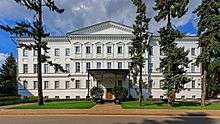
The art gallery in Nizhny Novgorod is a large and important art gallery and museums of human history and culture.
Nizhny Novgorod has a great and extraordinary art gallery with more than 12,000 exhibits, an enormous collection of works by Russian artists such as Viktor Vasnetsov, Karl Briullov, Ivan Shishkin, Ivan Kramskoi, Ilya Yefimovich Repin, Isaak Iljitsch Lewitan, Vasily Surikov, Ivan Aivazovsky, there are also greater collections of works by Boris Kustodiev and Nicholas Roerich, not only Russian art is part of the exhibition it include also a vast accumulation of Western European art like works by David Teniers the Younger, Bernardo Bellotto, Lucas Cranach the Elder, Pieter de Grebber, Giuseppe Maria Crespi, Giovanni Battista Piranesi, and lot more.
Finally what makes this gallery extremely important is the amazing collection Russian avant-garde with works by Kazimir Malevich, Wassily Kandinsky, Natalia Goncharova, Mikhail Larionov and so on. There is also collection of East Asian art.
Houses of worship
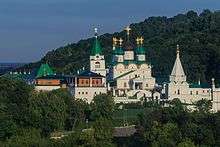

Other notable landmarks are the two great medieval abbeys. The Pechersky Ascension Monastery features the austere five-domed cathedral (1632) and two rare churches surmounted by tent roofs, dating from the 1640s. The Annunciation monastery, likewise surrounded by strong walls, has another five-domed cathedral (1649) and the Assumption church (1678). The only private house preserved from that epoch formerly belonged to the merchant Pushnikov.
There can be little doubt that the most original and delightful churches in the city were built by the Stroganovs in the nascent Baroque style. Of these, the Virgin's Nativity Church[26] (1719) graces one of the central streets, whereas the Church of Our Lady of Smolensk[27] (1694–97) survives in the former village of Gordeyevka (now, part of the city's Kanavinsky District), where the Stroganov palace once stood.
Other notable churches include:
- the Saviour Cathedral,[28] also known as the Old Fair Cathedral, a huge domed edifice built at the site of the great fair to an Empire style design by Agustín de Betancourt and Auguste de Montferrand in 1822;
- the so-called New Fair Cathedral,[29] designed in the Russian Revival style and constructed between 1856 and 1880 at the confluence of the Oka and the Volga. The New Fair Cathedral is the third tallest Cathedral in Russia;
- the recently reconstructed Church of the Nativity of John the Precursor[30] (1676–83), standing just below the Kremlin walls; it was used during the Soviet period as an apartment house;
- the parish churches of the Holy Wives[31] (1649) and of Saint Elijah[32] (1656);
- the Assumption Church on St Elijah's Hill[33] (1672), with five green-tiled domes arranged unorthodoxly on the lofty cross-shaped barrel roof;
- the shrine of the Old Believers at the Bugrovskoe cemetery,[34] erected in the 1910s to a critically acclaimed design by Vladimir Pokrovsky;
- the wooden chapel of the Intercession[35] (1660), transported to Nizhny Novgorod from a rural area.
There is also a mosque in Sennaya Square, where the Muslim populations of the city go for Friday prayers, Islamic activities and activities which are organized by the mosque. There is also a small shop to buy halal meats. Most of the Muslims in this city are Tatars.
The centrally located Nizhny Novgorod Synagogue was built in 1881-1883; disused during the Soviet era, it was renovated and reopened ca. 1991.
Other
A singular monument of industrial architecture is a 128-meter-high open-work hyperboloid tower built on the bank of the Oka near Dzerzhinsk as part of a powerline river crossing by the eminent engineer and scientist Vladimir Shukhov in 1929.
A staircase connecting the Kremlin with the Volga river offers a panoramic view of the surroundings. The staircase itself was constructed in the late 1940s by German prisoners of war forced to labor around Gorky.

Education

Nizhny Novgorod is home to the following educational facilities:
- N. I. Lobachevsky State University of Nizhny Novgorod
- Nizhny Novgorod State Technical University[36]
- Nizhny Novgorod State University of Architecture and Civil Engineering
- Nizhny Novgorod State Linguistic University
- Nizhny Novgorod State Pedagogical University
- Nizhny Novgorod State Medical Academy
- Nizhny Novgorod State Agricultural Academy
- Volgo-Vyatsky Region Civil Service Academy[37]
There are also twenty research institutes located in the city.
Sports
Several sports clubs are active in the city:
| Club | Sport | Founded | Current League | League Rank | Stadium |
|---|---|---|---|---|---|
| Nizhny Novgorod | Football | 1963 | Russian National Football League | 2nd | Lokomotiv Stadium |
| Torpedo Nizhny Novgorod | Ice Hockey | 1946 | Kontinental Hockey League | 1st | Trade Union Sport Palace |
| Start Nizhny Novgorod | Bandy | 1932 | Bandy Super League | 1st | Start Stadium |
| BC Nizhny Novgorod | Basketball | 2000 | VTB United League | 1st | Trade Union Sport Palace |
| Guberniya Nizhny Novgorod | Volleyball | 2008 | Volleyball Super League | 1st | FOK Zarechye |
| Sparta | Volleyball | 2000 | Women's Volleyball Supreme League A | 2nd | FOK Zarechye |
| Futbol-Hokkey NN | Futsal | 1996 | Futsal Supreme League | 2nd | FOK Krasnaya Gorka |
2018 FIFA World Cup
Russia will host the 2018 FIFA World Cup, and some matches will be played at the proposed Nizhny Novgorod Stadium. The stadium will be built on an island in the Volga river and will have a capacity of 44,899 people.[38]
Media

Nizhny Novgorod is the center of the television and radio broadcasting on the region and the Volga Federal District. There are local TV stations, the Internet and print media.
Newspapers
In city, there are some popular urban newspapers. Nizhegorodskaya Pravda, Stolitsa Nizhny and Nizhegorodsky rabochiy are Russian-language media headquartered in Nizhny Novgorod. Nizhegorodskaya pravda is the oldest newspaper of the city.
TV and radio

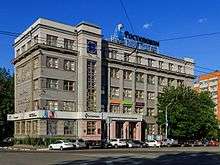
One of the first TV channel in the city is NNTV. It was created during the Soviet period, on the basis of the Gorky television. Also there is the TV channel Volga. The earlier existing most popular TV channel - Seti-NN, but he stopped broadcasting in December 2015.
Nizhny Novgorod television networks:
|
Nizhny Novgorod radio stations:
|
|
|
|
Notable people
International relations
Twin towns and sister cities
Nizhny Novgorod is twinned with:
 Essen, Germany[39]
Essen, Germany[39] Jinan, Shandong, China
Jinan, Shandong, China Kharkiv, Ukraine
Kharkiv, Ukraine Linz, Austria
Linz, Austria Matanzas, Cuba
Matanzas, Cuba Bitola, Republic of Macedonia
Bitola, Republic of Macedonia Novi Sad, Serbia
Novi Sad, Serbia Philadelphia, United States
Philadelphia, United States Sant Boi de Llobregat, Spain
Sant Boi de Llobregat, Spain Suwon, South Korea
Suwon, South Korea Tampere, Finland
Tampere, Finland Minsk, Belarus
Minsk, Belarus Vilnius, Lithuania
Vilnius, Lithuania Barcelona, Spain
Barcelona, Spain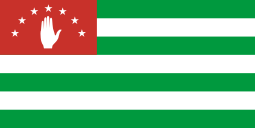 /
/ Sukhumi, Abkhazia/Georgia (disputed)
Sukhumi, Abkhazia/Georgia (disputed) Győr, Hungary
Győr, Hungary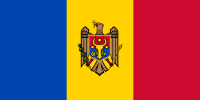 Bălți, Moldova
Bălți, Moldova /
/ Simferopol, Ukraine/Russia (disputed)
Simferopol, Ukraine/Russia (disputed)
References
Notes
- 1 2 3 4 5 6 7 Law #184-Z
- ↑ "Nizhny Novgorod". calend.ru. Retrieved 2016-08-15.
- 1 2 3 Law #205-Z
- ↑ Charter of Nizhny Novgorod, Article 26.1.2
- ↑ Official website of Nizhny Novgorod. (Russian)
- ↑ Charter of Nizhny Novgorod, Article 26.1.1
- ↑ Official website of Nizhny Novgorod. Overview of the city (Russian)
- 1 2 3 Russian Federal State Statistics Service (2011). "Всероссийская перепись населения 2010 года. Том 1" [2010 All-Russian Population Census, vol. 1]. Всероссийская перепись населения 2010 года (2010 All-Russia Population Census) (in Russian). Federal State Statistics Service. Retrieved June 29, 2012.
- ↑ The value of density was calculated automatically by dividing the 2010 Census population by the area specified in the infobox. Please note that this value may not be accurate as the area specified in the infobox does not necessarily correspond to the area of the entity proper or is reported for the same year as the population.
- ↑ Правительство Российской Федерации. Федеральный закон №107-ФЗ от 3 июня 2011 г. «Об исчислении времени», в ред. Федерального закона №271-ФЗ от 03 июля 2016 г. «О внесении изменений в Федеральный закон "Об исчислении времени"». Вступил в силу по истечении шестидесяти дней после дня официального опубликования (6 августа 2011 г.). Опубликован: "Российская газета", №120, 6 июня 2011 г. (Government of the Russian Federation. Federal Law #107-FZ of June 31, 2011 On Calculating Time, as amended by the Federal Law #271-FZ of July 03, 2016 On Amending Federal Law "On Calculating Time". Effective as of after sixty days following the day of the official publication.).
- 1 2 "Founding of Nizhny Novgorod". nizhnynovgorod.com. Retrieved 2016-08-15.
- 1 2 "Orthographic dictionary". gramota.ru. Archived from the original on 2011-08-21. Retrieved 2008-09-18.
- ↑ Почта России. Информационно-вычислительный центр ОАСУ РПО. (Russian Post). Поиск объектов почтовой связи (Postal Objects Search) (Russian)
- ↑ "Contacts". adm.nnov.ru. Retrieved 2016-08-15.
- 1 2 Decree of October 22, 1990, Article 1
- 1 2 Russian Federal State Statistics Service (May 21, 2004). "Численность населения России, субъектов Российской Федерации в составе федеральных округов, районов, городских поселений, сельских населённых пунктов – районных центров и сельских населённых пунктов с населением 3 тысячи и более человек" [Population of Russia, Its Federal Districts, Federal Subjects, Districts, Urban Localities, Rural Localities—Administrative Centers, and Rural Localities with Population of Over 3,000] (XLS). Всероссийская перепись населения 2002 года [All-Russia Population Census of 2002] (in Russian). Retrieved August 9, 2014.
- 1 2 Demoscope Weekly (1989). "Всесоюзная перепись населения 1989 г. Численность наличного населения союзных и автономных республик, автономных областей и округов, краёв, областей, районов, городских поселений и сёл-райцентров" [All Union Population Census of 1989: Present Population of Union and Autonomous Republics, Autonomous Oblasts and Okrugs, Krais, Oblasts, Districts, Urban Settlements, and Villages Serving as District Administrative Centers]. Всесоюзная перепись населения 1989 года [All-Union Population Census of 1989] (in Russian). Институт демографии Национального исследовательского университета: Высшая школа экономики [Institute of Demography at the National Research University: Higher School of Economics]. Retrieved August 9, 2014.
- ↑ "Pogoda.ru.net" (in Russian). Weather and Climate (Погода и климат). Retrieved December 10, 2015.
- ↑ "Gorkij (Nizhny Novgorod) Climate Normals 1961-1990". National Oceanic and Atmospheric Administration. Retrieved April 8, 2015.
- ↑ "Google".
- ↑ "Russian Railways Sapsan to Nizhny Novgorod press release".
- ↑ В связи с закрытием автовокзала на Лядова меняется расписание пригородных автобусов (Due to the closing of the Lyadov Sq bus terminal, schedule of commuter buses changes), 2015-01-29
- ↑ Полный список автобусов, которые будут отправляться с новой автостанции «Щербинки»: Новый вокзал откроется 25 октября (Full list of bus routes which will depart from the new Scherbinki bus terminal. The new terminal will open on October 25), 2015-10-19
- ↑ ">"Technical and operational parameters of subways in 2015" (PDF). The International Association "Metro".
- ↑ "Россия – российские авиалинии". Rossiya-airlines.com. July 25, 2007. Retrieved November 16, 2012.
- ↑ "Нижний Новгород-Церковь Собора Пресвятой Богородицы ("Строгановская")".
- ↑ "Нижний Новгород. Церковь Смоленской иконы Божией Матери, фотография".
- ↑ "Нижний Новгород-Собор Происхождения Честных Древ Креста Господня (Спасский Староярмарочный)".
- ↑ "Нижний Новгород-Кафедральный собор Александра Невского ("Новоярмарочный")".
- ↑ "Нижний Новгород. Церковь Рождества Иоанна Предтечи на Торгу, фотография".
- ↑ "Нижний Новгород. Церковь Жён-Мироносиц на Верхнем посаде, фотография".
- ↑ "Нижний Новгород. Церковь Илии Пророка, фотография".
- ↑ "Нижний Новгород. Церковь Успения Пресвятой Богородицы на Ильинской горе, фотография".
- ↑ "Нижний Новгород. Церковь Успения Пресвятой Богородицы на новом Бугровском кладбище, фотография".
- ↑ "Нижний Новгород. Музей-заповедник "Щёлоковский хутор". Церковь Покрова Пресвятой Богородицы из с. Зелёного Городецкого района, фотография".
- ↑ http://www.nntu.sci-nnov.ru/nstu.html
- ↑ "Нижегородский институт управления - филиал РАНХиГС (бывш. ВВАГС)". Vvags.ru. 2012-06-25. Retrieved 2013-03-26.
- ↑ Archived October 12, 2009, at the Wayback Machine.
- ↑ "List of Twin Towns in the Ruhr District". © 2009 twins2010.com. Archived from the original (PDF) on November 28, 2009. Retrieved 2009-10-28.
Sources
- Munro-Butler-Johnstone, Henry Alexander, A trip up the Volga to the fair of Nijni-Novgorod, Oxford: J. Parker and co., 1876.
- Fitzpatrick, Anne Lincoln, The Great Russian Fair: Nizhnii Novgorod, 1840-90, Houndmills, Basingstoke, Hampshire: Macmillan, in association with St. Antony’s College, Oxford, 1990. ISBN 0-333-42437-9
- Городская Дума города Нижнего Новгорода. №91 23 ноября 2005 г. «Устав города Нижнего Новгорода». Вступил в силу с 1 января 2006 г., но не ранее официального опубликования после государственной регистрации, за исключением подпункта 13 пункта 10 статьи 43, вступающего в силу в сроки, установленные федеральным законом, определяющим порядок организации и деятельности муниципальной милиции. Опубликован: "Нижегородский рабочий", №234/15894, 30 декабря 2005 г. (City Duma of the City of Nizhny Novgorod. #91 November 23, 2005 Charter of the City of Nizhny Novgorod. Effective as of January 1, 2006, but not earlier than the official publication date following the state registration, and with the exception of subitem 13 of item 10 of Article 43, which takes effect during the timeframe to be set by a federal law legislating the organization and functioning of the municipal militsiya.).
- Законодательное собрание Нижегородской области. Закон №184-З от 16 ноября 2005 г. «Об административно-территориальном устройстве Нижегородской области», в ред. Закона №67-З от 13 мая 2015 г «Об изменении административно-территориального деления Чкаловского района Нижегородской области и о внесении изменения в статью 11 Закона Нижегородской области "Об административно-территориальном устройстве Нижегородской области"». Вступил в силу по истечении десяти дней со дня официального опубликования. Опубликован: "Нижегородские новости", №218(3390), 23 ноября 2005 г. (Legislative Assembly of Nizhny Novgorod Oblast. Law #184-Z of November 16, 2005 On the Administrative-Territorial Structure of Nizhny Novgorod Oblast, as amended by the Law #67-Z of May 13, 2015 On Changing the Administrative-Territorial Structure of Chkalovsky District of Nizhny Novgorod Oblast and on Amending Article 11 of the Law of Nizhny Novgorod Oblast "On the Administrative-Territorial Structure of Nizhny Novgorod Oblast". Effective as of after ten days from the day of the official publication.).
- Законодательное Собрание Нижегородской области. Закон №205-З от 22 декабря 2005 г. «О утверждении границ, состава территории городского округа город Нижний Новгород», в ред. Закона №16-З от 7 февраля 2011 г «О внесении изменений в отдельные Законы Нижегородской области». Вступил в силу по истечении десяти дней со дня официального опубликования. Опубликован: "Нижегородские новости", №2(3414), 11 января 2006 г. (Legislative Assembly of Nizhny Novgorod Oblast. Law #205-Z of December 22, 2005 On Establishing the Borders, Territorial Composition of the Urban Okrug of the City of Nizhny Novgorod, as amended by the Law #16-Z of February 7, 2011 On Amending Various Laws of Nizhny Novgorod Oblast. Effective as of after ten days from the day of the official publication.).
- Президиум Верховного Совета РСФСР. Указ от 22 октября 1990 г. «О переименовании города Горького в город Нижний Новгород и Горьковской области в Нижегородскую области». (Presidium of the Supreme Soviet of the RSFSR. Decree of October 22, 1990 On Changing the Name of the City of Gorky to the City of Nizhny Novgorod and the Name of Gorky Oblast to Nizhny Novgorod Oblast. ).
External links
| Wikivoyage has a travel guide for Nizhny Novgorod. |
- Official website of Nizhny Novgorod
- NIZHNY NOVGOROD - 2018 FIFA World Cup™ Host City on YouTube by FIFA
- Nizhny Novgorod Kremlin (Russian)
- Official website of Nizhny Novgorod State Art Museum (Russian)
- The Nizhny Novgorod and Arzamas Archdiocese (Russian)
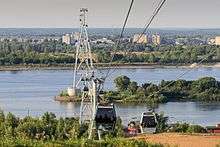
_-_new_terminal.jpg)